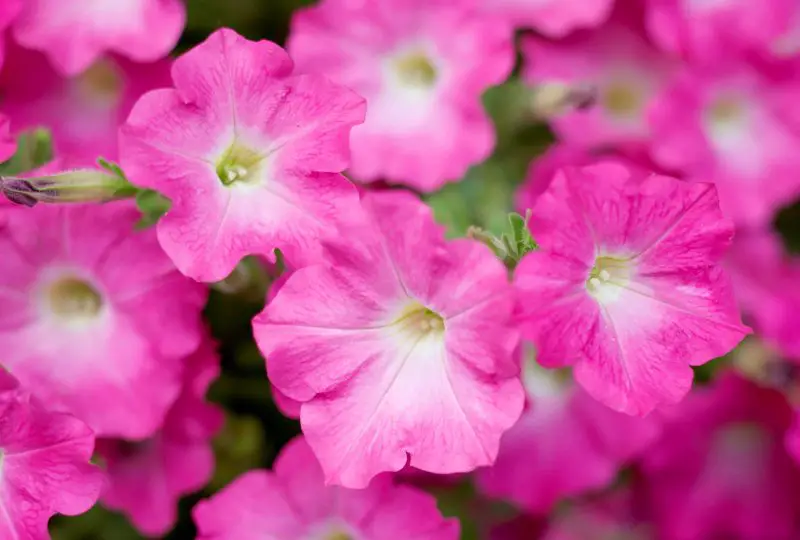Petunias bring life and color to every garden they touch. Their vivid blooms, soft texture, and sweet scent make them a favorite for gardeners everywhere. These flowers thrive in warm weather and reward consistent care with months of continuous color. Many gardeners grow them in pots, beds, or hanging baskets because they adapt easily to different spaces. Petunias bloom freely, filling gardens with brightness from early spring until the chill of autumn arrives.
However, their beauty doesn’t last forever unless you care for them properly. Petunias need sunlight, balanced watering, and pruning to stay healthy and full of blooms. When given attention, they can live and flower much longer than expected. Understanding how long petunias last and what affects their lifespan helps you keep them thriving throughout the season. In this guide, you’ll learn exactly how to extend their blooming time, maintain their strength, and enjoy vibrant, long-lasting displays that keep your garden glowing week after week.
Understanding the Lifespan of Petunias

Petunias are typically grown as annuals, meaning they complete their life cycle within one growing season. However, with the right conditions, they can continue to bloom for several months, often from early spring through the first frost. Most petunias live and flower for three to four months when cared for properly, though in mild climates, they may last up to six months or even longer. Their longevity depends on consistent watering, adequate sunlight, and protection from extreme temperatures. Healthy petunias often begin to fade only when the weather becomes too cold or when their growth slows due to age or lack of maintenance.
The type of petunia you grow also influences how long it will last. Grandiflora petunias, with their large blooms, are stunning but tend to be more sensitive to heat and rain, which can shorten their flowering period. Multiflora and wave varieties, on the other hand, are hardier and bloom continuously throughout summer with proper care. These spreading petunias are especially resilient, able to tolerate heat, wind, and moderate drought, giving them a longer blooming window. Choosing the right variety for your region ensures lasting color and stronger performance throughout the season.
Environmental factors play a major role in determining lifespan. Petunias love warmth and light but dislike prolonged humidity and heavy rainfall. Too much water or poor drainage can cause root rot, while insufficient sun can reduce blooming. In ideal conditions—full sun, well-draining soil, and regular deadheading—petunias can bloom for months without pause. With a little extra care and attention, your plants can remain healthy and radiant far longer than their typical growing season, filling your garden with beauty that endures from spring to frost.
Factors That Affect How Long Petunias Last
Sunlight Exposure
Sunlight plays the most vital role in determining how long petunias last and how abundantly they bloom. Petunias are true sun-lovers, needing at least six to eight hours of direct light every day. Without sufficient sun, they struggle to produce flowers, and their stems become thin, elongated, and weak. In shaded areas, the plants may survive, but their energy shifts toward leaf production instead of flowering. This leads to fewer blooms and shorter lifespans. Consistent sunlight keeps the plant vigorous, supports healthy photosynthesis, and helps the flowers maintain their bright colors for weeks at a time.
However, excessive exposure to intense midday sun, especially in extremely hot regions, can cause stress. The petals may fade, and the leaves can develop sun scorch. To balance this, gardeners in warmer climates should provide light afternoon shade to prevent overheating. Container-grown petunias can be moved to slightly sheltered areas during the hottest hours while still receiving ample morning light. In cooler climates, placing them in full sun ensures maximum flowering. With proper light management, petunias maintain steady growth and continuous blooming from early spring well into autumn, extending their beauty far beyond expectations.
Watering and Moisture Balance
Water management is another crucial factor that directly impacts how long petunias thrive. These plants prefer soil that is consistently moist but never soggy. Overwatering suffocates the roots, leading to rot and fungal diseases, while underwatering causes wilting and premature flower drop. Striking the right balance ensures steady growth, healthy foliage, and a prolonged blooming period. In well-drained soil, deep watering encourages roots to grow downward, making the plant more drought-tolerant over time. Consistency in watering habits helps petunias resist stress from heat and fluctuating weather conditions.
The watering frequency depends on the environment and soil type. In garden beds, watering two to three times a week may be enough, while hanging baskets or pots often require daily hydration, especially in warm climates. Water early in the morning to let excess moisture evaporate through the day, preventing fungal buildup on the leaves. Adding a layer of mulch around the base helps maintain even moisture and reduces evaporation. With steady hydration and good drainage, petunias stay vibrant, strong, and capable of producing blooms far longer than their typical lifespan.
Temperature and Climate Conditions
Temperature and climate consistency heavily influence petunia longevity. These flowers thrive in warm weather, ideally between 60°F and 75°F. Extreme temperatures—either too hot or too cold—can drastically shorten their blooming period. When exposed to frost, petunias die back quickly, while intense heat above 90°F causes them to wilt and stop flowering. Maintaining an even temperature range encourages continuous blooms and steady plant health. In areas with fluctuating climates, petunias benefit from being grown in containers, which can be moved as needed to avoid stress.
During cooler months, bringing containers indoors or covering garden beds on chilly nights helps prolong the season. In hot climates, provide some shade during peak afternoon hours and increase watering to prevent heat stress. Petunias grown under stable conditions remain lush, colorful, and productive for months. Some gardeners in mild regions can even keep them alive year-round by overwintering them indoors. By managing temperature and weather exposure carefully, you can dramatically extend their flowering season and enjoy fresh, bright blossoms well beyond the summer months.
How to Make Petunias Bloom Longer
Keeping petunias blooming for months requires a combination of proper care, consistent maintenance, and timely intervention. The secret lies in understanding how the plant grows and ensuring it always has the right conditions to thrive. Petunias bloom most vigorously when their energy goes toward producing flowers rather than seeds. Regular deadheading—removing faded flowers before they can form seeds—encourages the plant to redirect its energy into new blooms. This simple habit can double the flowering time. In addition, providing the plants with plenty of sunlight, consistent watering, and a balanced fertilizer helps sustain healthy growth and vibrant color through every stage of the season.
Feeding plays a major role in prolonged flowering. Petunias are heavy feeders and require consistent nutrition to produce wave after wave of blooms. Use a fertilizer high in phosphorus, such as a 10-15-10 formula, every two weeks during the growing season. Avoid fertilizers with too much nitrogen, as this will cause lush leaves but fewer flowers. Regular feeding strengthens stems, deepens flower color, and improves endurance against heat or mild drought. Combined with deep watering and good drainage, this ensures your petunias never stop blooming, even under demanding weather conditions.
Light pruning is another important technique to extend blooming. As the season progresses, petunias can become leggy and sparse. Cutting the stems back by one-third rejuvenates growth, allowing new side shoots and flower buds to form. After pruning, water well and feed lightly to support regrowth. Within a couple of weeks, the plants will burst back into bloom with renewed strength and density. When given steady care, pruning, and feeding, petunias can continue flowering from early spring right through to the first frost, turning your garden into a non-stop display of color and fragrance.
Seasonal Care for Petunias to Extend Their Lifespan
Spring Care: Establishing Strong Growth
Spring marks the beginning of the petunia growing season, and early care determines how well they’ll bloom later. Start by planting petunias after the last frost, when soil temperatures are warm and stable. Choose a sunny location with good drainage to encourage root development and strong initial growth. Early feeding with a balanced fertilizer helps young plants establish quickly. Water consistently, keeping the soil moist but not waterlogged, as young roots are sensitive to overwatering. Pinch back the first few blooms to encourage branching and fuller growth later in the season.
As temperatures rise, focus on helping the plants adjust to outdoor conditions. Move container-grown petunias gradually into full sunlight to prevent sun scorch. Keep an eye out for early pests such as aphids or slugs, which can damage tender new shoots. Applying mulch around the base of the plants helps maintain soil moisture and prevents weeds from competing for nutrients. A strong start in spring ensures healthy, resilient petunias that will reward you with abundant blooms as summer arrives.
Summer Care: Maintaining Continuous Blooms
Summer is the peak season for petunias, but it’s also when they require the most attention. The combination of heat, dry air, and intense sunlight can stress the plants if not properly managed. Water deeply every few days, ensuring the soil stays evenly moist, especially for container-grown petunias that dry out quickly. Deadhead faded blooms regularly to keep new flowers coming and prevent seed formation. Applying a liquid fertilizer every two weeks maintains the nutrients needed for nonstop flowering.
During very hot spells, petunias may temporarily slow their bloom production. If this happens, prune back leggy stems by one-third to rejuvenate growth. Providing light afternoon shade during extreme heat helps prevent wilting and prolongs the flower’s vibrancy. Check regularly for pests like whiteflies or spider mites, which thrive in warm weather. With consistent watering, feeding, and pruning, petunias will continue to bloom beautifully, adding a burst of color throughout the hottest months of summer.
Fall Care: Preparing for the End of the Season
As temperatures cool in fall, petunias begin to slow down, but proper care can extend their blooming into the early weeks of the season. Reduce watering gradually to prevent root rot in cooler, wetter conditions. Continue deadheading to encourage late blooms and maintain a tidy appearance. In regions with mild climates, petunias can often keep flowering until the first frost, especially if protected from cold winds. Applying a final dose of low-nitrogen fertilizer helps strengthen roots for longer endurance.
Before frost arrives, decide whether to overwinter your petunias or replant next year. For overwintering, move container plants indoors to a bright, sunny spot and water lightly. Alternatively, take stem cuttings to propagate new plants for the next growing season. Clean up dead foliage and debris to prevent fungal issues and pests from overwintering in the soil. With careful fall maintenance, you can stretch the beauty of your petunias well beyond their usual season and prepare them for an even stronger comeback next year.
Reviving Petunias That Stop Blooming
Even the healthiest petunias can experience a midseason slump when their blooms slow down or stop entirely. This usually happens due to heat stress, nutrient depletion, or a buildup of old, faded flowers. The good news is that you can easily revive petunias and bring them back to full bloom with a few targeted steps. Start by inspecting the plants carefully—if they look leggy or sparse, it’s time for a deep pruning. Trim each stem back by about one-third, removing any dead or diseased foliage. This encourages the plant to redirect energy into new growth and fresh blooms. After pruning, water deeply and feed with a balanced fertilizer rich in phosphorus to stimulate flowering.
Next, focus on improving the plant’s growing environment. Ensure petunias receive enough sunlight—at least six to eight hours daily—and adjust watering habits if necessary. Overwatering can cause root rot, while dryness can stress the plant and reduce bloom production. Aim for evenly moist soil that drains well. In containers, replace the top layer of soil with fresh compost to replenish nutrients. For in-ground petunias, lightly work organic matter into the topsoil to restore fertility. Consistent feeding every two weeks helps sustain energy for continuous blooming.
Within two to three weeks after pruning and fertilizing, you should start seeing vigorous new growth and the return of bright, healthy flowers. To maintain this revival, continue deadheading regularly and keep an eye on weather conditions. If heat waves occur, offer light shade to reduce stress. Revived petunias often bloom even more intensely than before, rewarding your care with a renewed explosion of color that lasts until the first frost. With patience and proper maintenance, your petunias can rebound from any dull period and thrive beautifully once again.
Common Mistakes That Shorten the Lifespan of Petunias
Overfertilizing with Nitrogen
Overfertilizing is one of the biggest reasons petunias stop blooming early. Many gardeners assume that frequent feeding with nitrogen-rich fertilizer will make their plants grow faster, but the opposite often happens. Excess nitrogen pushes the plant to produce thick foliage instead of flowers. The leaves may look lush and green, but blooms become sparse and weak. Over time, the soil accumulates too many salts from fertilizer, which can burn the roots and stunt growth. This imbalance not only shortens the blooming period but also weakens the plant’s resistance to disease.
To prevent this, use fertilizers formulated for flowering plants—preferably those higher in phosphorus and potassium, like 10-15-10 or 20-10-20 blends. These nutrients encourage bud development and root health rather than excess leaf production. Feed petunias every two to three weeks during the growing season and always water before applying fertilizer to protect the roots. If the soil starts showing white crusts on the surface, flush it thoroughly with clean water to remove salt buildup. Controlled feeding keeps your petunias balanced, helping them produce rich, colorful blooms and thrive for months longer than expected.
Inconsistent Watering
Watering inconsistency is another mistake that can cut a petunia’s life short. Petunias depend on steady soil moisture to grow and flower continuously. If the soil dries out completely between waterings, the plant experiences stress that causes flowers to drop and leaves to wilt. Conversely, keeping the soil constantly soggy deprives roots of oxygen, leading to rot. Both extremes—overwatering and underwatering—damage the plant’s health and shorten its lifespan. Stress from irregular moisture also makes petunias more vulnerable to diseases like gray mold and root fungus.
The best way to avoid this problem is to maintain a regular watering schedule based on soil conditions and weather. Water deeply so moisture reaches the root zone, then allow the top inch of soil to dry before watering again. Petunias in containers or hanging baskets dry out faster, so check them daily, especially in hot weather. Morning watering is ideal because it gives plants time to absorb moisture and dry out before nightfall. A light mulch layer around the base of garden petunias helps retain moisture evenly. Stable watering habits keep the plants hydrated, healthy, and blooming continuously from spring to frost.
Ignoring Pests and Diseases
Neglecting pest and disease control is another common reason petunias fail to reach their full lifespan. Pests such as aphids, spider mites, and caterpillars feed on leaves and stems, draining the plant’s energy and distorting new growth. Fungal problems like powdery mildew and botrytis thrive in humid or crowded environments, causing brown spots, wilted leaves, and rotting blooms. When these issues are ignored, the plant weakens quickly and may stop flowering altogether. Even mild infestations can spread rapidly if not addressed early.
To keep petunias healthy, inspect them at least twice a week, paying attention to the undersides of leaves where pests often hide. Remove infested leaves by hand and spray the plant with neem oil or insecticidal soap. If fungal infections appear, improve airflow by thinning dense foliage and avoid overhead watering. Affected plants should be treated promptly with a mild fungicide to stop the spread. Keeping your garden clean, well-spaced, and properly ventilated is the best prevention. When petunias stay pest-free and disease-resistant, their blooms last longer, and their overall vitality improves significantly.
Extending Petunia Blooms Through Proper Pruning
Regular pruning is one of the most effective yet often overlooked ways to extend the lifespan and blooming period of petunias. As the season progresses, petunias tend to become leggy, producing fewer flowers on long, thin stems. This natural growth habit often gives the impression that the plant is fading, but in reality, it simply needs a refresh. By pruning back each stem by about one-third, you stimulate new side shoots that develop into compact, flower-covered branches. This process encourages continuous flowering while improving the plant’s shape and overall health.
In addition to structural pruning, deadheading plays a critical role in keeping petunias blooming. When old flowers are left on the plant, energy shifts to seed production instead of new blooms. Regularly removing spent blossoms redirects that energy into growth and flowering, ensuring that your petunias remain covered in vibrant color throughout the season. Deadheading also helps reduce fungal diseases by improving air circulation and preventing decay on dying petals. This simple routine, when done consistently, makes an enormous difference in the plant’s longevity and appearance.
After pruning and deadheading, it’s essential to water deeply and feed the plants with a phosphorus-rich fertilizer to promote new buds. Within two to three weeks, healthy regrowth and fresh flowers will appear. For petunias grown in containers or hanging baskets, pruning also prevents overcrowding and encourages airflow. Whether in garden beds or pots, routine trimming transforms tired, lanky petunias into lush, full plants that maintain a continuous wave of blooms from spring through autumn. With proper pruning care, your petunias will reward you with unmatched vitality and color.
Revitalizing Old Petunia Plants
As petunias mature, they often lose vigor, producing fewer flowers and developing woody stems. This decline doesn’t mean the plant’s life is over—it’s simply a signal that rejuvenation is needed. Old petunia plants can be revitalized effectively with strategic pruning, soil renewal, and targeted feeding. Begin by cutting back the plants to about half their height, removing faded leaves, damaged stems, and any parts that appear dry or brittle. This aggressive pruning stimulates fresh shoots and restores symmetry, preparing the plant for a new flush of blooms.
Feeding is just as important as pruning during the rejuvenation process. Older petunias often suffer from nutrient depletion, especially if they’ve been growing in the same soil for months. Apply a water-soluble fertilizer rich in phosphorus and potassium to strengthen the roots and promote flower formation. Avoid heavy nitrogen fertilizers, as these encourage leafy growth instead of blooms. Adding fresh potting mix or compost to the soil also replenishes essential nutrients and improves drainage, both of which are key to recovery.
After trimming and feeding, place the revitalized petunias in a sunny spot where they receive at least six hours of direct light each day. Maintain consistent watering, keeping the soil evenly moist but never soggy. Within a few weeks, you’ll notice new shoots forming at the base and bright flower buds reappearing. Rejuvenated petunias can continue to bloom beautifully well into late summer or fall, extending their lifespan and keeping your garden full of fresh, colorful displays. With the right approach, even aging petunias can regain their charm and vitality.
FAQs About Petunia Lifespan and Blooming
How long do petunias usually last?
Petunias typically last for about three to four months during the growing season, from spring until the first frost. In mild climates with proper care, they can thrive for up to six months. Regular watering, feeding, and pruning can extend their lifespan, allowing them to bloom beautifully for most of the year.
Why do my petunias stop blooming in midsummer?
Petunias often pause blooming during midsummer because of extreme heat, lack of nutrients, or poor pruning habits. High temperatures can stress the plant, causing flowers to fade or stop forming. To fix this, prune the plant back, feed with a bloom-boosting fertilizer, and water consistently to encourage new growth and fresh blooms.
Can petunias survive more than one season?
While petunias are usually treated as annuals, they can survive longer in warm climates or indoors. Overwintering them in containers near bright light and mild temperatures keeps them alive for another season. Many gardeners also take stem cuttings before frost to grow new plants that bloom the following year.
How do I keep my petunias blooming continuously?
Deadhead old flowers regularly, prune leggy stems, and fertilize every two weeks with a phosphorus-rich formula. Make sure they receive at least six hours of sunlight daily and keep the soil evenly moist. With consistent care, petunias will keep producing vibrant blooms all season long without long breaks.
What’s the best fertilizer for longer-lasting blooms?
Use a balanced fertilizer such as 10-15-10 or 20-10-20 to encourage both growth and continuous flowering. High-phosphorus blends promote stronger roots and more abundant blooms. Avoid fertilizers with excessive nitrogen, as they produce leafy growth instead of flowers. Feed every two to three weeks for consistent color and vitality.
Conclusion
Petunias bring unmatched color, energy, and elegance to any garden, but their beauty lasts longest when given the right care. By understanding their needs—sunlight, moisture, nutrition, and pruning—you can keep them blooming for months on end. Consistent deadheading, proper feeding, and regular rejuvenation ensure your petunias remain lush, vibrant, and full of life. Whether planted in garden beds, hanging baskets, or containers, these flowers reward attention with continuous waves of color. With a little patience and dedication, your petunias will not only last longer but also flourish more beautifully, turning every corner of your garden into a lasting display of joy and brilliance.






